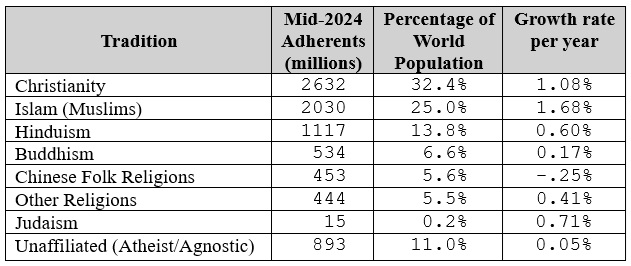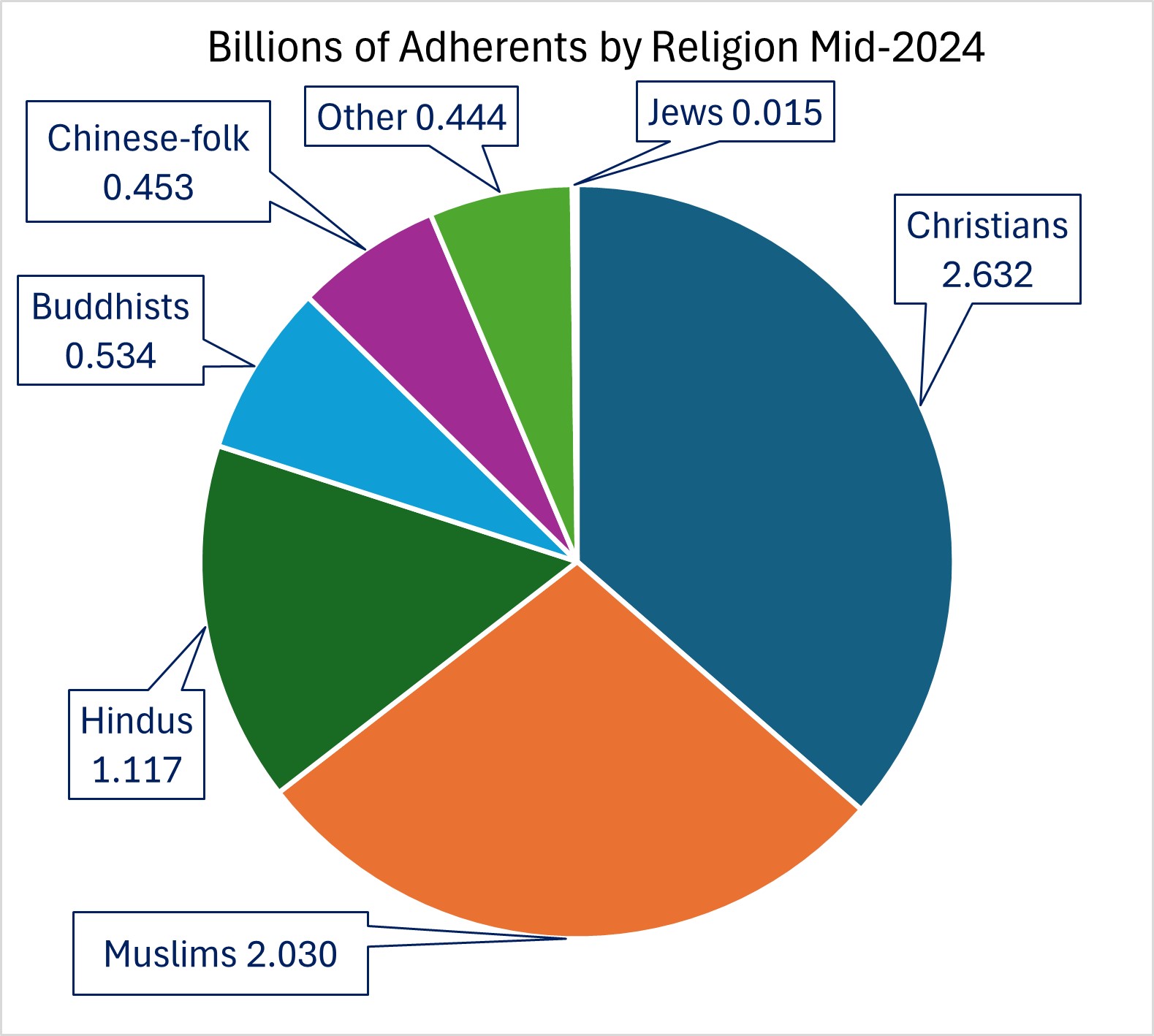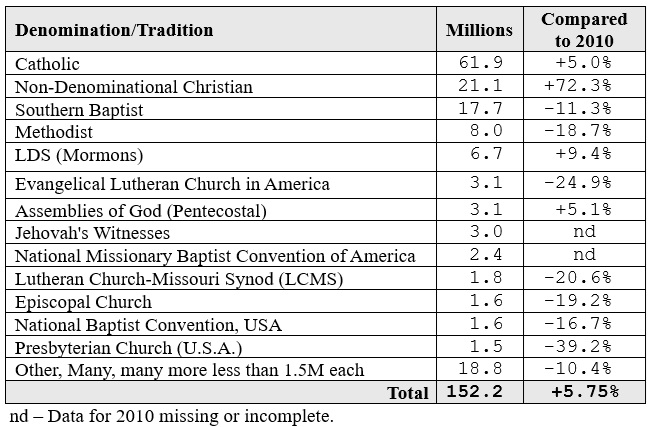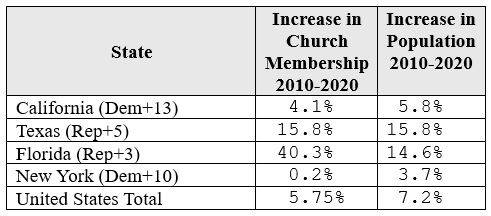
Is Christianity in Decline? What do the numbers show?
The popular press these days seems to delight in publishing articles asserting that religion, and especially Christianity, is in rapid decline. We see some people trying to quash religion in our schools and the government even though the US was founded on Judeo-Christian principles. Many people try to misconstrue the freedom of religion stated in the First Amendment, "Congress shall make no law respecting an establishment of religion," to mean freedom from religion rather than simply that the government will not establish a state religion.
The beginning of the Declaration of Independence says:
When in the Course of human events, it becomes necessary for one people to dissolve the political bands which have connected them with another, and to assume among the powers of the earth, the separate and equal station to which the Laws of Nature and of Nature's God entitle them, a decent respect to the opinions of mankind requires that they should declare the causes which impel them to the separation.
We hold these truths to be self-evident, that all men are created equal, that they are endowed by their Creator with certain unalienable Rights, that among these are Life, Liberty and the pursuit of Happiness…
Later in the document, it says:
We, therefore, the Representatives of the united States of America, in General Congress, Assembled, appealing to the Supreme Judge of the world for the rectitude of our intentions,…
And for the support of this Declaration, with a firm reliance on the protection of divine Providence,…
With all these explicit references to God, does it sound like our founders intended that we distance ourselves from our religion? I think not; they intended to create a country where people were free to worship how they wanted to worship. They did not intend to create a country of atheists.
Global Numbers
Let's examine the global numbers to see if religion is really in decline. Several organizations publish statistics about religion. I looked at the United Nations World Population Prospects 2024 report, the World Christian Database, the Association of Religion Data Archives, the US Religion Census, the CIA World Factbook, the World Population Review, and Pew Research for the data.
The world's population is around 8.185 billion and is growing at a rate of 0.87% per year, which is down significantly from the growth rates in the 1960s and 1970s, which topped 2% per year. Source: United Nations World Population Prospects 2024.
According to the World Christian Database, in mid-2024, about 89% of people in the world identified with a religion. Overall, the practice of religion is growing at just below 1% per year, which is faster than the rate of population growth.
Here is the breakdown by tradition:


Other includes - Ethnic Religions, New Religious Movements, and Sikhs.
This data answers one of our questions. Religious practice is not dying out worldwide; it is growing faster than the population. This is because the two largest traditions worldwide, Christianity and Islam, are growing faster than the rate of the population. While Christianity is the largest tradition, Islam is currently growing faster than Christianity. Projecting these rates forward, that would mean that Islam could become the largest religion around 2070.
When I delved more deeply into the data, I found that the largest growth in Christianity, year over year, is occurring in Africa (2.64%) and Asia (2.11%). In this data, Christianity is shrinking in Europe, including Russia (-0.39%) and more slowly in North America (-0.16%.) That data set did not break out the United States from North America. It will be interesting to see how the recent migration of people from around the world into the United States will impact those numbers in the future.
Within Christianity, by far the largest faith tradition is Catholic. Worldwide, Catholics comprise between 47% and 50% of all Christians, depending on whose data you use. Protestants comprise about 36% of Christians, and Eastern Orthodox comprise 11% of Christians.
Protestants are not a unified body. There are thousands of Protestant denominations. The largest traditions are; Anglican, the World Communion of Reformed Churches, Methodist, Lutheran, World Assemblies of God (Pentecostal), and Baptist. However, there are many divisions within each of those traditions. It should be noted that non-denominational churches are on the rise. Many of those churches practice one of the traditions above but did not want to be under the thumb of the organizational structure of those denominations. According to the World Christian Database, Protestantism is growing at over double the rate of Catholicism.
United States Numbers
The Association of Statisticians of American Religious Bodies conducts a religion census every ten years in the United States. They contact as many religious organizations in the US as possible and ask for data about their membership. I was able to access that data via the Association of Religion Data Archives. This data shows how many people are active members of the various churches. The most recent data is from 2020, and data is available for 2010, 2000, 1990, and 1980, so this is a good source for assessing the trends.
From that data, in the United States, Protestants outnumber Catholics, but Catholicism is still the largest single denomination. According to the Association of Religion Data Archives, 2020 US Religion Census, the largest Christian denominations/traditions in 2020 were:

From this data, Catholics and Assemblies of God (Pentecostal) have small growth, and LDS is growing well. There is a major shift going on from the traditional mainline protestant denominations to Non-denominational churches. Also, the mainline denominations are breaking up over social issues. For example, since 2020, over 7,600 churches have broken off from the United Methodist Church. Some 3,700 of them have joined the new Global Methodist Church so far. The Episcopal Church (Anglican) is shrinking quickly, but the Anglican Church in North America is growing. The Presbyterian Church (U.S.A.) is shrinking rapidly, but the Presbyterian Church in America is growing. People or whole churches are moving from these traditions to Non-denominational churches.
When I compared the data for the US from 2010 to 2020, I observed a small percentage growth, of 5.75%, in the number of Christians. However, the population grew 7.35% in the same time. So, while there was an increase in the number of Christians who are active members of churches, there is a decrease in the percentage of Christians as compared to the size of the population from 46.6% in 2010 to 45.9% in 2020. I looked back at the data from 2000, 1990, and 1980 and found the same situation: the number of Christians that are active members of churches is growing each decade, but not as fast as the growth in population. The percentage of Christians that are active members of churches in the population dropped from about 52% in 1980 to 45.9% in 2020, but the raw numbers grew from 111.8 million in 1980 to 152.2 million in 2020.
These numbers, which are based on the numbers reported by the various denominations, give a significantly different impression than the plethora of recent articles claiming that Christianity is in rapid decline in the US. It is more honest to say that Christianity is growing but slower than the population.
Interestingly, Pew Research and other organizations say that 63% of Americans self-identify as Christian in 2020, down from 78% ten years earlier. They say that in the 1970s and 1980s, 90% of people in the US identified as Christian. Yet the data above does not show a decline in church membership.
It may be that there is a decline in the number of people “self-identifying” as Christian, but the number of people showing up at the churches has increased. However, they are moving around between denominations or to non-denominational churches. Perhaps it has become more socially acceptable to admit that you are not active in any religion than it was in the past, and people are fessing up more.
Politics and Religion
I ran across an article in Politico titled "The Religious Landscape is Undergoing Massive Change. It Could Decide the 2024 Election." It discussed the religion census data and mentioned that religion is growing in some areas of the country and shrinking in others. There was a quote that struck me:
Democrats are making gains in areas where religion is fading and Republicans are increasing their vote share in places where houses of worship are gaining new members.
That statement made me curious, so I looked at the religion census data, filtering for Christians for the four largest population states, California, Texas, Florida, and New York, and compared 2010 to 2020. Florida and Texas became more religious, and California and New York became less religious:

From the US Religion Census data, based on Church Attendance, the most religious states were Utah (Rep+13), Alabama (Rep+15), and Louisiana (Rep+12). The least religious states were New Hampshire (Dem+1), Maine (Dem+2), and Oregon (Dem+6).
The World Population Review, based on survey data, has the most religious states as Alabama (Rep+15), Mississippi (Rep+11), Tennessee (Rep+14), and Louisiana (Rep+12) and the least religious as New Hampshire (Dem+1), Massachusetts (Dem+15), Vermont (Dem+16), and Maine (Dem+2).
You can draw your own conclusions from this data.
Sources: US Religion Census, Maps and data files for 2020, 2020 Summary data by nation, state, county and metro. World Population Review, Most Democratic States 2024
Summary/Conclusions
Worldwide, Christianity is growing faster than the population, as explained above, but not as fast as Islam. In the US, Christianity is growing, but at a rate slower than the population. The percentage of people who self-identify as Christian has declined significantly from around 90% in the 1970s and 1980s to 63% in 2020. However, the data reported by the various denominations, in aggregate, shows a steady increase in people attending over the same period.
The population of the United States is just over 346 Million now. If the numbers above are correct, we have the opportunity to try to reach the 37% of the population, 128 million people, who do not identify as Christian. Also, we need to figure out how to welcome back to our churches the 17%, 59 million people, who identify as Christian, but who do not attend any Churches. We have our work cut out for us!
Douglas A. Leas, November 2024
Sources:
The Association of Religion Data Archives, U.S. Membership reports: accessed October 30, 2024. https://www.thearda.com/us-religion/census/congregational-membership
United Nations World Population Prospects 2024 report, https://population.un.org/wpp/
World Christian Database, https://www.worldchristiandatabase.org/
CIA World Factbook, Religions, https://www.cia.gov/the-world-factbook/field/religions/
Pew Research, Modeling the Future of Religion in America, accessed October 30, 2024 https://www.pewresearch.org/religion/2022/09/13/how-u-s-religious-composition-has-changed-in-recent-decades/
Politico (2023), “The Religious Landscape is Undergoing Massive Change. It Could Decide the 2024 Election.” https://www.politico.com/news/magazine/2023/05/14/democrats-religion-census-secular-00095858
World Population Review, https://worldpopulationreview.com
Association of Statisticians of American Religious Bodies, US Religion Census, https://www.usreligioncensus.org
Public Religion Research Institute, 2023 PRRI Census of American Religion, https://www.prri.org/research/census-2023-american-religion